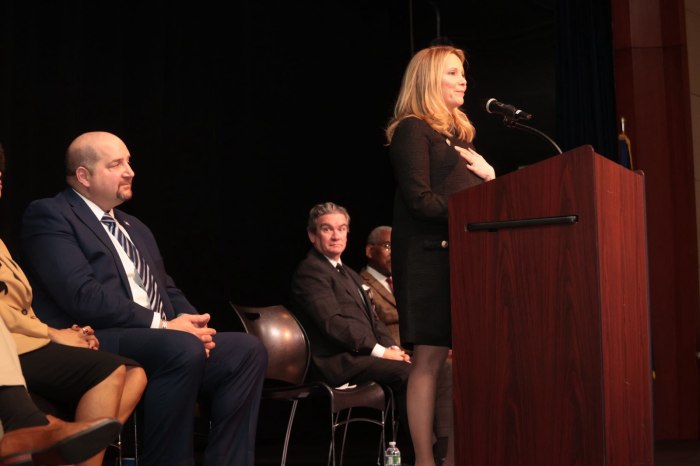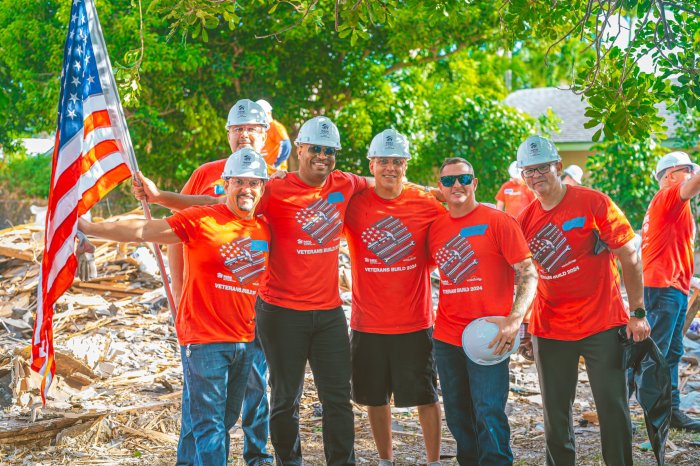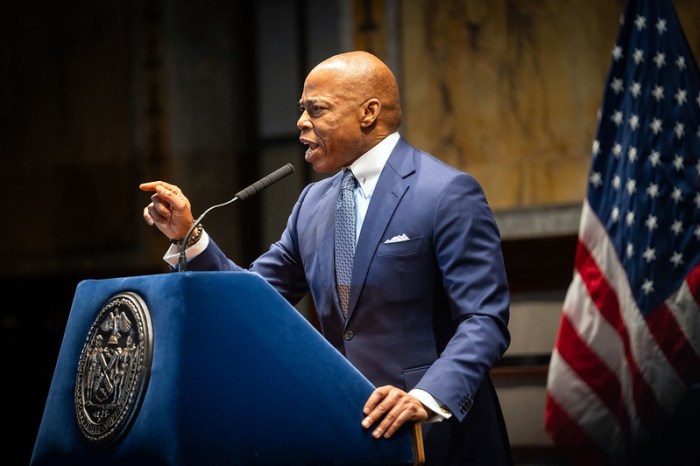By Alec MacGillis, ProPublica
In March, I was driving along a road that led from Dayton, Ohio, into its formerly middle-class, now decidedly working-class southwestern suburbs, when I came upon an arresting sight. I was looking for a professional sign-maker who had turned his West Carrollton ranch house into a distribution point for Trump yard signs, in high demand just days prior to the Ohio Republican primary. Instead of piling the signs in the driveway, he had arrayed them in his yard along the road. There they were, dozens and dozens of them, lined up in rows like the uniform gravestones in a military cemetery.
The sign man wasn’t home, but he had left a married couple in charge of the distribution. I got talking to the woman, Contessa Hammel. She was 43 and worked at the convenience store at a local Speedway gas station after four years in the military. And this was the first time she was voting in 25 years of eligibility.
I was startled to hear this — it’s rare to find voters entering the political process after decades of disconnection; in fact, I’d met a handyman in his 70s at a Trump rally on the other side of Dayton that same day who said he was voting for the first time, but I had dismissed it as a fluke.
I asked Hammel why she’d held back all those years. “I didn’t want to make an unintelligent decision,” she said, in a tone that suggested she was well aware of what an admission that was. But this year’s Republican nominee was different, she said. “He makes it simple for people like me,” she said. “He puts it clearly.”
Donald Trump’s stunning win Tuesday, defying all the prognosticators, suggested there were many more people like Hammel out there — people who were so disconnected from the political system that they were literally unaccounted for in the pollsters’ modeling, which relies on past voting behavior.
But Hammel was far from the only person I met in my reporting this year who made me think that Trump had spurred something very unusual. Some of them had never voted before; some had voted for Barack Obama. None were traditional Republican voters. Some were in dire economic straits; others were just a notch up from that and looking down with resentment at the growing dependency around them. What they shared were three things. They lived in places that were in decline, and had been for some time. They lacked strong attachment to either party at a time when, even within a single metro area like Dayton, the parties had sorted themselves into ideological, geographically disparate camps that left many voters unmoored. And they had profound contempt for a dysfunctional, hyper-prosperous Washington that they saw as utterly removed from their lives.
These newly energized voters helped Trump flip not only battlegrounds like Ohio and Iowa but long-blue Northern industrial states — Pennsylvania, Michigan, Wisconsin — without which he would have lost to Hillary Clinton. Nationwide, his margin with the white working class soared to 40 points, up 15 points from Romney’s in 2012.
Two days after meeting Hammel, I tagged along with some Trump supporters, women who’d come all the way from Buffalo to go canvassing door-to-door in the adjacent Dayton suburb of Miamisburg. It was a rainy day, and few were answering their doors in this neighborhood of frayed frame houses and bungalows, but they persisted in their yellow ponchos; I couldn’t help but be reminded of the doggedness I’d observed among Obama volunteers in 2008.
At one small house, someone finally answered the door. Tracie St. Martin stepped out onto the porch, a 54-year-old woman with a sturdy, thick-muscled build and sun-weathered face, both of them products of her 26 years as a heavy-construction worker. St. Martin greeted the women warmly, and when they told her what they were there for she said, sure, she was considering Trump — even though she usually voted Democratic. And when they got talking, in the disjointed way of canvassers making a quick pitch, about how Trump was going to bring back the good jobs, St. Martin was visibly affected. She interrupted them, wanting to tell them about how she had, not long ago, worked a job that consisted of demolishing a big local GM plant. Her eyes welled up as she told the story and she had trouble continuing.
The canvassers gave her some materials and bade her farewell. But I doubled back a little later and visited with St. Martin in her kitchen, which she was in the midst of tidying up, with daytime TV playing in the background. Space in the kitchen was tight due to the treadmill she recently bought to help her get into better shape, which she hoped might make her less dependent on the painkillers for the severe aches she got from her physically demanding job, pills that had gotten a lot harder to obtain from her doctor amid the clampdown on prescription opioids.
St. Martin apologized, unnecessarily, for her emotions on the porch and expanded on what she had told the women from Buffalo: She was a proud member of Local 18 of the operating engineers’ union, which had been urging its members to support Hillary Clinton. The union provided her health insurance and decent pay levels, and trained her for demanding work, which, just months earlier, had required her to hang off of a Pennsylvania cliff face in her dozer as part of a gas pipeline project.
She came from a staunch Democratic family and had voted for Barack Obama in 2008, before not voting in 2012 because, she said, she was away on one of her long-term jobs. She was a single mother with three grown daughters. She had experienced all manner of sexual discrimination and harassment on very male-heavy worksites over the years.
She was, in other words, as tailor-made a supporter as one could find for Clinton, a self-professed fighter for the average Jane who was running to become the first woman president.
And yet St. Martin was leaning toward Trump.
Her explanation for this was halting but vehement, spoken with pauses and in bursts. She was disappointed in Obama after having voted for him. “I don’t like the Obama persona, his public appearance and demeanor,” she said. “I wanted people like me to be cared about. People don’t realize there’s nothing without a blue-collar worker.” She regretted that she did not have a deeper grasp of public affairs. “No one that’s voting knows all the facts,” she said. “It’s a shame. They keep us so fucking busy and poor that we don’t have the time.”
When she addressed Clinton herself, it was in a stream that seemed to refer to, but not explicitly name, several of the charges thrown against Clinton by that point in time, including her handling of the deadly 2012 attack by Islamic militants on U.S. facilities in Benghazi, Libya; the potential conflicts of interest at the Clinton Foundation; and her use of a private email server while serving as Secretary of State, mixing national security business with emails to her daughter, Chelsea.
“To have lives be sacrificed because of corporate greed and warmongering, it’s too much for me — and I realize I don’t have all the facts — that there’s just too much sidestepping on her. I don’t trust her. I don’t think that — I know there’s casualties of war in conflict, I’m a big girl, I know that. But I lived my life with no secrets. There’s no shame in the truth. There’s mistakes made. We all grow. She’s a mature woman and she should know that. You don’t email your fucking daughter when you’re a leader. Leaders need to make decisions, they need to be focused. You don’t hide stuff.
“That’s why I like Trump,” she continued. “He’s not perfect. He’s a human being. We all make mistakes. We can all change our mind. We get educated, but once you have the knowledge, you still have to go with your gut.”
Hand-wringing among Democrats about the party’s declining support among white working-class voters goes back a long time, to Lyndon Johnson’s declaration that signing the Civil Rights Act would sacrifice the allegiance of white Southerners. Then came the rest of the historical litany: the crime wave, riots and anti-Vietnam War protests of the late 1960s, the consolidation of suburban white flight, Nixon’s Silent Majority, Reagan Democrats, NAFTA, gun control, the War on Coal, and on and on. By this year, many liberals had gotten so fed up with hearing about these woebegone voters and all their political needs that they were openly declaring them a lost cause, motivated more by racial issues than economic anxiety, and declaring that the expanding Democratic coalition of racial and ethnic minorities and college-educated white voters obviated the need to cater to the white working class.
But this assessment suffered from a fatal overgeneralization. The “white working class” was a hugely broad category — as pollsters defined it, any white voter without a four-year college degree, roughly one-third of the electorate. Within that category were crucial distinctions, especially regional ones. Democrats in national elections had lost most white working-class voters in the Deep South — indeed, virtually all white voters there — a long time ago. They had in the past decade and a half seen much of Greater Appalachia, stretching from the Alleghenies to Arkansas, follow suit, to the point where West Virginia, one of just five states that Jimmy Carter won in 1980, went for Mitt Romney by 26 percentage points in 2012. It was hard to see how the Democrats were going to win back coal country like Logan County, W.V., which Bill Clinton won with 72 percent in 1996 but where Obama got only 29 percent in 2012.
But there was a whole subset of the white working class Obama was still winning: voters in northern states where unions, however diminished, still served to remind members of their Democratic roots (and build inter-racial solidarity). In these states, voters could still find national figures who represented them and their sort, people like Ohio Sen. Sherrod Brown and Vice President Joe Biden. Lackawanna County, Pennsylvania, centered on Biden’s hometown of Scranton, went for Obama with 63 percent of the vote in 2012. Rural Marquette County, in Michigan’s Upper Peninsula, went for him with 56 percent of the vote. In Ohio, there were a couple counties in the state’s Appalachian southeast that went stronger for Obama in 2012 than they had in 2008. In the opposite corner of the state, gratitude for Obama’s bailout of the auto industry helped win him 64 percent of the vote in Lucas County, around Toledo. Across the North, Obama ran even or ahead with John Kerry and Al Gore among white working class voters; their raw vote total for him nationwide exceeded his tallies of college-educated white voters and minority supporters.
On Election Day 2012, one voter I spoke with in Columbus, Ohio, encapsulated how well Obama had managed to frame the election as a “who’s on your side” choice between himself and the private equity titan Mitt Romney, and thereby hold onto enough white working-class voters in crucial swing states. Matt Bimberg, 50, was waiting by himself at a remote bus stop in a black neighborhood on the edge of town. He had in the past decade lost jobs as a telecom technician for Global Crossing (he still carried a Global Crossing tote bag) and at a factory making escape hatches for buses. But he had just landed a job at a nearby warehouse as a forklift operator, a success for which he credited a three-week training course paid for by the U.S. Department of Labor. And as gratitude for that, he was voting for Obama after voting for John McCain in 2008. “My line of thinking was that under Romney and [Paul] Ryan, it would be more of a trickle-down administration,” he said. “Their thinking is to give that money to corporations and the rich in tax breaks, and some will trickle down. But it didn’t work then and it won’t work now. Romney reminds me so much of Reagan’s theory of supply-side economics. It scares me.”
Not so long ago, Hillary Clinton would have seemed ideally suited to keep such northern white working-class voters in the fold. After all, she had trounced Obama among many of these very voters in the 2008 primaries, as she beat him in states such as Ohio and Pennsylvania and at one point went so far as to declare herself, in a slip of the tongue, the champion of “working, hard-working Americans, white Americans.”
But things had changed in the intervening years. For one thing, she was further removed from her stint representing downtrodden upstate New York as a senator — she had spent the years since 2008 in the rarefied realm of the State Department and then giving more than 80 paid speeches to banks, corporations and trade associations, for a total haul of $18 million. For another thing, cause for resentment and letdown had grown in many of those Rust Belt communities where Obama had held his own — they might be inching their way back from the Great Recession, but the progress was awfully slow, and they were lagging ever further behind booming coastal cities like New York, San Francisco and Washington, where the income gap compared with the rest of the country had grown far larger.
Most crucially, she was running not against Mitt Romney, the man from Bain Capital, but against Donald Trump. Yes, Trump was (or claimed to be) a billionaire himself, but he was not of Romney’s upper crust — they scorned him and his casinos and gold-plated jet, and were giving him virtually none of their campaign contributions. Trump attacked the trade deals that had helped hollow out these voters’ communities, he attacked the Mexicans who had heavily populated some of their towns and had driven much of the heroin trade in others, and, yes, he tapped into broader racial resentments as well. Faced with this populist opposition, Clinton fatefully opted against taking the “I’m on your side; he’s not” tack that Obama had used so well against Romney, and had instead gone about attacking Trump’s fitness for the presidency.
Back in Dayton, where Clinton never visited during the entire campaign, I had run into two more former Obama voters after Trump’s March rally there. Both Heath Bowling and Alex Jones admitted to having been swept up in the Obama wave, but had since grown somewhat disenchanted. Bowling, 36, a burly man with a big smile, managed a small siding and insulation business, and as he’d grown older he’d had gotten more bothered about the dependency on food stamps he saw around him, especially among members of his own generation, and demoralized by the many overdose deaths in his circle.
Jones, 30, who worked part-time at a pizza shop and delivering medicines to nursing homes, joked at first that his vote for Obama might have had to do with his having been doing a lot of drugs at the time. He grew serious when he talked about how much the Black Lives Matter protests against shootings by police officers grated on him. Chicago was experiencing soaring homicide rates, he said — why weren’t more people talking about that? He was upset that when he went out on the town in Cincinnati’s Over-the-Rhine bar district, he had to worry about getting jumped if he was on the street past a certain hour — and that he felt constrained against complaining against it. “If I say anything about that, I’m a racist,” he said. “I can’t stand that politically correct bullshit.” He had, he said, taken great solace in confiding recently in an older black man at a bar who had agreed with his musing on race and crime. “It was like a big burden lifted from me — here was this black man agreeing with me!”
Polls had consistently showed that Trump’s support was stronger with white working-class men than women, and in October came a revelation that seemed sure to weaken his standing among women of all classes, release of an 11-year-old tape in which Trump boasted of trying to commit adultery with a married woman and grabbing women “by the pussy.”
A few days after the release of the tape, which was followed by a string of accusations from women saying they had been sexually harassed and assaulted by Trump, I checked back in with Tracie St. Martin to see if she still supported him. She was working on a new gas plant in Middletown, a working-class town near Dayton that was the setting of the recent best-selling memoir “Hillbilly Elegy.” Here’s what she wrote back in a text message: “I still appreciate the honesty in some of his comments. Most of his comments. I still favor what he says he may be able to do. I am voting against Hillary, come what may with Trump. It’s important to me that ‘we the people’ actually have political power. And electing Trump will prove that. I am AMAZED at the number of people voting for him. The corruption is disgusting in the press. Yes, as of right now I am voting FOR Trump.” She was sure he would win, she said: “His support is crazy! The polls have to be wrong. Have to be fixed.”
And she shared an anecdote that reflected how differently Trump’s comments had been received in some places than others. “I’m setting steel for this new gas plant…I’m operating a rough terrain forklift,” she wrote. “So today, I kept thinking about the debate and the audio was released … And I got underneath a load of steel and was moving it…I was laughing and laughing and one of the iron workers asked ‘what are u laughing at.’ I said ‘I grabbed that load right by the pussy’ and laughed some more…And said ‘when you’re an operator you can do that ya know’, laughed all fucking day.”
Just last week, I was back in Ohio, in the southeastern Appalachian corner. I was at a graduation ceremony for opiate addicts who had gone through a recovery program, and sitting with four women, all around 30, who were still in the program. Someone mentioned the election, and all four of them piped up that they were voting for the first time ever. For whom? I asked. They looked at me as if I had asked the dumbest question in the world. All four were for Trump.
The most of the loquacious of the group, Tiffany Chesser, said she was voting for him because her boyfriend worked at a General Electric light-bulb plant nearby that was seeing more of its production lines being moved to Mexico. She saw voting for Trump as a straightforward transaction to save his job. “If he loses that job we’re screwed — I’ll lose my house,” she said. “There used to be a full parking lot there — now you go by, there are just three trucks in the lot.”
But Chesser also was viscerally opposed to Clinton who, the week prior, had endured a surprise announcement from FBI Director James Comey that a newly discovered cache of emails of hers was under scrutiny. “If she’s being investigated by the FBI, there’s a reason for it,” she said. I asked the women if they weren’t equally bothered by the many women’s accusations against Trump. They shrugged. “It’s locker-room talk,” Chesser said. “I know girls talk like that, and I know guys do.” But what about the accusations of assault? “Why are they just coming forward now?” she said. “If he did it to me before, I’d have come forward then. I wouldn’t wait until now.”
The next day, I met with Taylor Sappington, a native of Southeast Ohio who, after graduating from Ohio University, had decided to run for town council last year in Nelsonville, pop. 5,400, and won a seat. Sappington, who had been raised in a manufactured home by a single mother and whose brother works as a corrections officer, was a proud Democrat. He had volunteered for Obama’s 2012 campaign and took comfort in knowing that parts of Southeast Ohio had remained solid for the Democrats, unlike so much of the rest of Appalachia. But he knew that Clinton would not perform as well in the area as Obama had. “It’s a Democratic area. But Trump has blown a hole through it,” he said. “They feel like this is a forgotten area that’s suffering, that has been forgotten by Columbus and Washington and then they hear someone say, we can turn this place around, they feel it viscerally.”
And he feared that the national Democratic Party did not realize how little it could afford such a loss, or even realize how well it had those voters in the fold as recently as 2012. “I’m a believer in the Democratic coalition, but they’re writing off folks and it’s going to hurt them,” he said. “To write them off is reckless.”
A week later, on Election Day, I drove to a polling station in Shrewsbury, Pennsylvania, a small town south of York, just across the Maryland line. The polling station was inside an evangelical church housed inside a vast, mostly abandoned shopping plaza. It’s Republican country, where Romney outpolled Obama 2–1, but I was still startled by how long it was taking me to find a single Hillary Clinton voter.
But there was yet another woman voting for the first time in her life, at age 55, for Trump. “I didn’t have much interest in politics. But the older you get you realize more and more how important it is,” said Kelly Waldemire, who works in a local plastic-molding plant. “When it got to the point where the country is going in the wrong direction, I thought it was time.”
And there was yet another voter who had been for Obama in 2008 — Brian Osbourne, a 33-year-old Navy veteran who now drove all the way to Washington, D.C., every day to do commercial HVAC work because it paid double there what it would in Shrewsbury. The local economy had come back a little, he said, but “there’s a lot of people working jobs that they’re overqualified for.” That wasn’t all, he said. He hesitated, warning that what he was about to say wasn’t “politically correct,” and then said, “We’re really getting pussified as a country.”
I asked what he made of reports that Trump wrote off as much of a billion dollars on his taxes to avoid paying any at all. He shrugged it off just as every Trump voter I spoke with there did. “That doesn’t worry me all that much,” he said. “That’s what he does — that’s the loophole the government created. He takes advantage of what the system created. I’d do the same thing.”
As for Obama, his promise of racial reconciliation had been a “big letdown,” he said. “I thought it would help with race relations, but it’s getting way worse,” he said. “I wouldn’t be surprised if we have another civil war in this country.”
And there were yet more women willing to wave off Trump’s comment on the tape and the women’s accusations against him. “I don’t take that crap seriously,” said Tammy Nuth, 49, who cares for Alzheimer’s patients. “Men are men.” As for the women accusers: “I think they’re getting paid off.”
As I was preparing to leave, I glimpsed a young woman who I guessed might’ve voted for Clinton, and approached her to help balance my reporting. I was wrong. Stephanie Armetta, an 18-year-old working as a grocery store cashier before heading to community college, had cast her first-ever ballot, for Donald Trump. Her family had many members in the military, she said, and she thought Trump would “have more respect” for them. She thought it was wrong that if her brother got deployed, he got only two meals per day, while people in prison get three. And then of course there was Benghazi, “that she left [the four Americans] there, that they weren’t her priority.” She was bothered by Trump’s comments on the tape, for sure. But, she said, “I’m glad how he didn’t lie about it. They caught him and he said, yeah, I said an asshole thing.” Not to mention, she said, “Bill Clinton isn’t good either on that subject.” Her vote, she concluded, was “more against Hillary than for Trump.”
Trump won that one small precinct by 144 more votes than Romney had won it in 2012 — a 20 percent increase. And all across rural and small-town Pennsylvania, that pattern repeated itself. In Scranton’s Lackawanna County, where Obama had won 63 percent, Clinton won only 50 percent.
In Michigan’s rural Marquette County, where Obama had won 56 percent, Clinton got only 49 percent. Trump became the first Republican since 1988 to win Pennsylvania or Michigan.
In Ohio’s Mahoning County, home of Youngstown, where Obama got 63 percent, Clinton got only 50 percent. In Hocking County, just adjacent to Nelsonville, Clinton fell even further, getting 30 percent, down from the 48 percent Obama had gotten, and realizing Taylor Sappington’s fears.
And at Tracie St. Martin’s working-class precinct in Miamisburg, where Obama had managed to get 43 percent in 2012, Clinton’s support plunged to 26 percent, giving Trump a margin of 293 votes just in that one precinct, triple Romney’s margin four years earlier. That helped provide Trump a historic claim: the first Republican majority in Dayton’s Montgomery County in 28 years. Statewide, Trump won by a whopping eight percentage points, a swing of 10 points from four years earlier. He had brought new voters out of the woodwork; he had converted some white working-class Obama voters while others had just stayed home.
St. Martin, who was still hard at work on the Middletown gas plant with a “great bunch of ironworkers,” was elated. “I just really needed to know that I was part of a majority that recognized we need these things that Trump spoke of,” she told me. “More importantly for me, to NOT have Hillary as Commander in Chief.”
ProPublica is a Pulitzer Prize-winning investigative newsroom. Sign up for their newsletter.
































